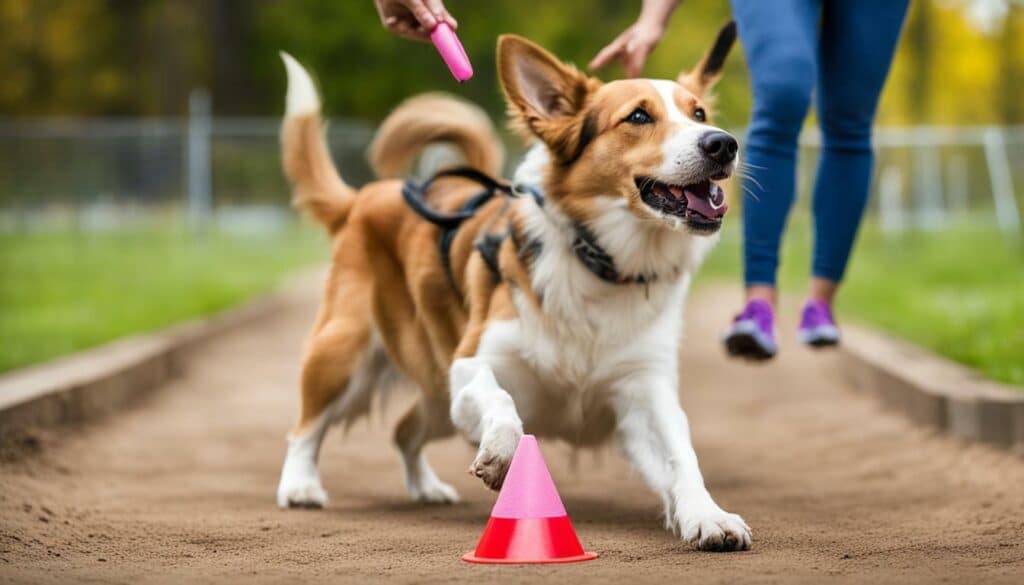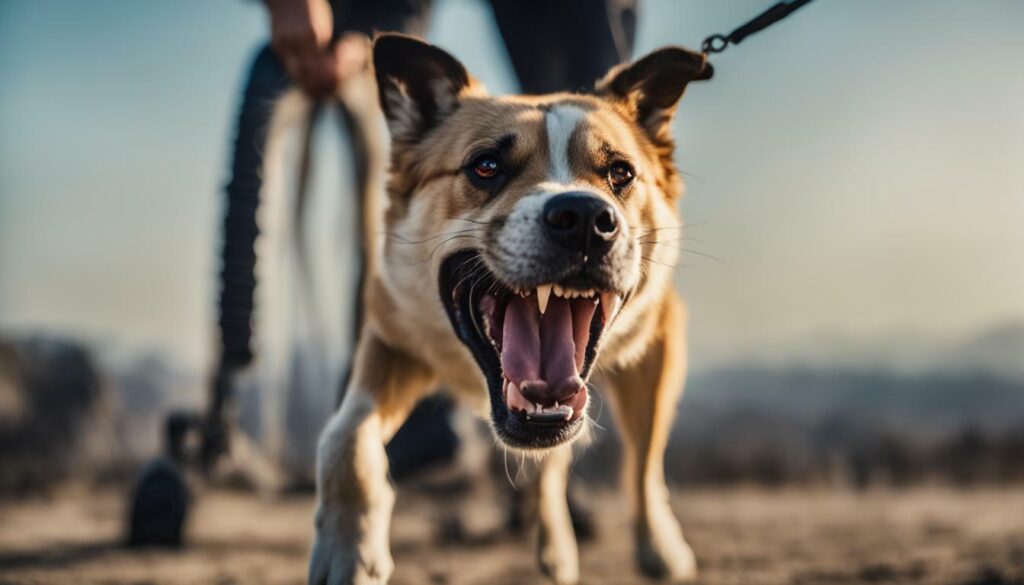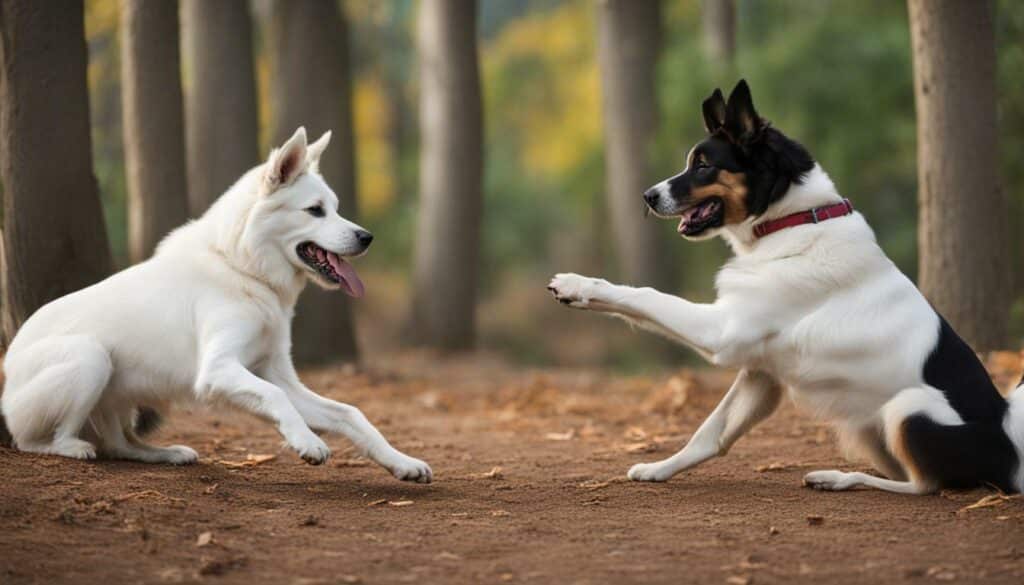Decoding Dog Behavior: A Comprehensive Guide for Pet Owners

In this comprehensive guide, I will take you through the fascinating world of decoding dog behavior. As a pet owner, it’s essential to have a clear understanding of your dog’s actions, communication, psychology, and training. By understanding the intricacies of dog behavior, you can build a stronger bond with your pet, address any potential behavioral issues, and ensure a happy and healthy relationship. Throughout this guide, we’ll explore various topics, including dog body language, vocalizations, socialization, aggression, anxiety, and breed-specific behavior. Let’s dive in and start decoding dog behavior together!
Before we dive into decoding specific behaviors, it’s crucial to have a basic understanding of dog behavior and psychology.
Dogs have their own unique way of communicating through body language, vocalizations, and behavior patterns. By learning about their natural instincts and social hierarchies, you’ll be better equipped to interpret your dog’s actions.
For instance, understanding the pack mentality of dogs is essential to understanding their behavior. Dogs are naturally social animals and have a hierarchy within their pack. When you bring a dog into your home, they see you and your family as their pack. It’s important to establish yourself as the pack leader, as this gives your dog a sense of security and guidance.
Dog psychology also plays a significant role in their behavior. Dogs have a strong sense of smell and are highly attuned to their environment. They rely heavily on their sense of smell to navigate their surroundings and to communicate with other dogs.
Understanding dog behavior and psychology can help you anticipate your dog’s needs and prevent potential behavioral issues. It’s also important to remember that each dog is unique and may have different behavior patterns and preferences.
By taking the time to learn and understand your dog’s behavior, you can build a strong bond with your furry friend and ensure their physical and mental well-being.
Dog Body Language: What They’re Trying to Tell You
As pet owners, understanding our dog’s body language is crucial in decoding their behavior. Dogs use their bodies to communicate a wealth of information, from their mood to their intentions. By learning to interpret their body language, we can gain valuable insights into our furry friends’ state of mind.
One of the most common cues we look for is a wagging tail. However, not all tail wags are equal. A wagging tail held high and stiff can signify aggression, while a loose and relaxed tail wag can indicate a playful or friendly mood. Similarly, a dog with ears held back and a lowered head may be displaying fear or submission, while an alert and upright posture can suggest attentiveness or aggression.
Other body language cues include a dog’s eye contact, mouth position, and stance. Direct eye contact can be seen as a challenge or threat, while avoiding eye contact can indicate fear or submission. A dog with an open and relaxed mouth is likely to be at ease, while a dog with a closed and tight mouth may be feeling anxious or tense. A dog’s stance can also provide insight into their mood and intentions, with a wide and lowered stance suggesting aggression and a relaxed and loose stance indicating friendliness or playfulness.
It’s important to note that body language cues should always be interpreted in context and in combination with other signals, such as vocalizations and behavior patterns. By paying attention to our dog’s body language and behavior, we can better understand their needs and feelings, and address any potential behavioral issues before they escalate.
Dogs communicate a wealth of information through their body language. By interpreting their signals, you can gain valuable insight into their emotions and intentions. Understanding dog behavior is essential to building a strong bond with your pet and addressing any behavioral issues that may arise.
Tail wagging, ear positioning, and facial expressions are just a few examples of how dogs use their bodies to communicate. However, it’s important to remember that body language cues should be interpreted in context. For example, a wagging tail does not always indicate friendliness.
In general, a relaxed and loose body posture indicates that a dog is comfortable and content. Conversely, a stiff posture may indicate fear or aggression. A dog with its ears back or its tail tucked may also be displaying fear or submission.
It’s essential to pay attention to a dog’s facial expressions, as they can provide valuable insight into its emotional state. For example, a raised eyebrow or wrinkled forehead may indicate confusion or anxiety, while a relaxed and open mouth may indicate contentment.
By observing your dog’s body language in different situations, you can better understand their needs and emotions. This understanding can help you to avoid potential conflicts and create a happier and healthier relationship with your pet.
Understanding dog behavior and psychology is crucial for successful dog socialization. Socialization is the process of exposing your dog to various people, animals, and environments to ensure they develop appropriate social skills. It’s important to start socializing your dog from a young age, but it’s never too late to start!
When socializing your dog, it’s essential to monitor their behavior and reactions. If your dog seems fearful or anxious, take a step back and slowly introduce them to new experiences. Gradual exposure is key to helping your dog become comfortable and confident in new situations.
Positive reinforcement training is an effective way to encourage good behavior during socialization. This includes rewarding your dog for exhibiting desired behaviors, such as greeting other dogs calmly.
It’s also important to expose your dog to a variety of environments, such as busy streets, parks, and dog-friendly businesses. This helps your dog become accustomed to different sights, sounds, and smells.
Remember, socialization is an ongoing process that requires patience and commitment. By investing time in socializing your dog, you can prevent behavioral issues and build a stronger bond with your furry friend.
Training your dog is an essential part of decoding their behavior. Positive reinforcement techniques are highly effective in teaching your dog desired behaviors. Positive reinforcement involves rewarding your dog with treats, praise, or affection for exhibiting good behavior. This approach focuses on encouraging wanted behaviors rather than punishing unwanted ones.
There are other training methods to consider beyond positive reinforcement. Some tools, such as shock collars or choke chains, can be harmful to your dog’s well-being and cause long-term behavioral issues. It’s crucial to choose training methods that align with your dog’s specific needs.
One highly effective training technique is clicker training. Clicker training uses a marker sound to signal to your dog that they have done something right. The click is followed by a treat or reward, creating a positive association with the behavior.
Another training technique to consider is shaping. Shaping involves breaking down a complex behavior into small steps and then rewarding your dog for successfully completing each step. This method requires patience and consistency but can be highly effective in teaching complex behaviors.
Keep in mind that training is not a one-time event. It requires ongoing practice, consistency, and patience. Make sure to set realistic training goals and break each behavior down into small, manageable steps.
Aggression is a serious behavioral issue in dogs that can have both physical and legal consequences. Understanding the root causes of aggression can help pet owners manage and prevent aggressive behavior.
Dog aggression can be caused by a variety of factors, including fear, territoriality, and lack of socialization. Some dogs may also display aggression due to medical conditions or pain. As a pet owner, it’s important to recognize the signs of aggression, which can include growling, snarling, biting, and lunging. If your dog displays any of these behaviors, seek professional help immediately.
Management and prevention of aggression require a combination of training, behavior modification, and environmental management. Understanding dog behavior and incorporating positive reinforcement techniques can be highly effective in managing aggression. For example, teaching your dog an alternative behavior to perform when trigger situations arise can redirect their attention and prevent aggression.
Decoding dog behavior also involves identifying and avoiding trigger situations that may lead to aggression. It’s crucial to manage your dog’s environment, including avoiding situations that may overstimulate or stress your dog. Additionally, managing your dog’s routine and providing plenty of physical and mental stimulation can help reduce anxiety and prevent aggressive behavior.
| Type of Aggression | Causes | Management Techniques |
|---|---|---|
| Fear aggression | Fear, anxiety, lack of socialization | Counter-conditioning, desensitization, positive reinforcement training |
| Territorial aggression | Perceived threat to territory or family | Environmental management, positive reinforcement training, behavior modification |
| Resource guarding | Protecting food, toys, or other resources | Positive reinforcement training, behavior modification, environmental management |
| Redirected aggression | Redirecting aggression toward an unintended target | Avoiding trigger situations, environmental management |
Managing dog aggression requires patience, consistency, and professional guidance. Seek the help of a certified professional dog trainer or veterinary behaviorist to develop a customized behavior modification plan for your dog. With the right approach, aggression can be managed and prevented, helping your dog lead a happy, healthy life.
Dogs are social animals and thrive on human companionship. When left alone, they may experience separation anxiety, a condition that causes excessive distress and destructive behavior.
Understanding dog behavior is crucial to helping your pet cope with separation anxiety. One of the first steps is identifying the signs of this condition, such as excessive barking, destructive behavior, and restlessness. If your dog displays any of these behaviors when you’re not around, they may be experiencing separation anxiety.
There are several strategies that you can use to help your dog cope. The first is to gradually acclimate them to being alone. Start by leaving them alone for short periods of time and gradually increasing the length of time over several weeks. This will help them develop confidence and independence.
Another effective strategy is providing them with a safe and comfortable space. This could be a crate or a designated area of the house where they can retreat to when they feel anxious. Provide them with toys, treats, and other comforts to help them feel secure.
Training techniques such as desensitization and counter-conditioning can also be effective in treating separation anxiety. These techniques involve gradually exposing your dog to the triggers that cause anxiety and reinforcing positive behaviors.
It’s important to remember that separation anxiety can be a serious condition that requires professional help. If your dog’s anxiety is severe, consult with a veterinarian or a professional dog trainer.
Fear and Phobias: Understanding and Supporting Your Dog
Fear and phobias are common in dogs and can be caused by a range of factors, including genetics, lack of socialization, past trauma, or environmental stimuli. If you notice your dog displaying signs of fear or anxiety, it’s important to take the time to understand their behavior and provide support.
Symptoms of fear and anxiety can manifest in a variety of ways, including trembling, panting, pacing, hiding, or destructive behavior. It’s important to remember that your dog’s behavior is their way of communicating with you, and it’s your job to decipher the message.
One way to support your dog through fear and phobias is by creating a safe and calming environment. This could include providing a quiet space for your dog to retreat to, using calming scents or music, or utilizing a ThunderShirt or other calming product.
Another strategy for supporting your dog is through desensitization and counterconditioning. This involves gradually exposing your dog to the source of their fear or anxiety in a controlled and positive environment, while rewarding them for calm behavior.
It’s important to be patient and consistent when working with your dog through fear and phobias. Seek the guidance of a professional dog trainer or behaviorist if needed, and remember that each dog is unique in their needs and responses.
Understanding and supporting your dog through fear and phobias is an important part of their overall well-being and happiness. By decoding their behavior and providing the necessary support, you can help your furry friend overcome their fears and live a more fulfilling life.
Body Handling and Grooming: Building Trust and Comfort
Dogs require regular grooming, including brushing, bathing, and nail trimming, to maintain their hygiene and appearance. However, some dogs may find these activities stressful or uncomfortable, which can result in fear or aggression. It’s crucial to build trust and comfort with your dog to ensure that grooming is a positive experience for both you and your furry friend.
Start by introducing your dog to grooming tools slowly and gradually. Allow them to sniff and inspect the tools before using them. Use positive reinforcement, such as treats or praise, to reward your dog for calm and relaxed behavior during grooming sessions.
If your dog displays fear or aggression during grooming, it’s essential to address the underlying cause of the behavior. This may involve consulting with a professional dog trainer or behaviorist to develop a customized plan for your pet.
Regular body handling can also help your dog become more comfortable with grooming. Start by touching your dog’s paws, ears, and tail gently. Gradually increase the duration and intensity of handling to desensitize your dog to these activities.
Remember to always approach grooming and body handling with patience and understanding. By building trust and comfort, you can ensure that grooming is a positive experience that strengthens your bond with your furry companion.
Understanding Breed-Specific Behavior
Each dog breed has its own unique set of behavior traits and tendencies, and as a pet owner, it’s essential to understand these characteristics. By doing so, you can better anticipate your dog’s needs and tailor your training and care accordingly.
For example, breeds such as Border Collies and German Shepherds are highly intelligent and require a lot of mental stimulation. They are also known for their herding instincts, which can lead to nipping or chasing behavior if not properly trained. Breeds such as Beagles and Basset Hounds have a strong sense of smell and may be more likely to follow their noses instead of obeying commands.
Understanding breed-specific behavior also means recognizing potential health issues that are common in certain breeds. For instance, breeds such as Bulldogs and Pugs may have difficulty breathing due to their short snouts, leading to respiratory problems. Similarly, breeds such as Labrador Retrievers and Golden Retrievers are predisposed to joint issues such as hip dysplasia.
Overall, understanding breed-specific behavior can help you provide the best possible care for your dog. By recognizing their unique traits and tendencies, you can create a tailored training and care plan that meets their needs and ensures a happy and healthy life.
Dogs are social animals and have a unique way of communicating with each other through body language and behavior. As a pet owner, it’s essential to understand their interactions to ensure a positive and safe experience for your furry friend. Decoding dog behavior is crucial in interpreting their intentions and emotions.
When two dogs meet, they usually approach each other cautiously while sniffing and wagging their tails. If both dogs continue to show interest, they may engage in play or move on to another activity. However, if one dog shows signs of aggression or fear, the situation can escalate, causing a dangerous situation.
One crucial aspect of interpreting dog interactions is understanding their body language. Dogs use body language to communicate a wealth of information, including their intentions and emotions. For instance, a dog holding its tail high indicates confidence and alertness, while a low-hanging tail signals submission or fear.
Other common body language cues include ear position, eye contact, and posture. It’s essential to observe these cues carefully to understand the underlying message. For example, a dog with its ears flattened and avoiding eye contact may show fear or aggression, while a dog with relaxed posture and bouncy movements indicates playfulness.
When interpreting dog interactions, it’s crucial to consider the context of the situation. Factors such as the dog’s breed, age, and personality can influence how they interact with other dogs. As a pet owner, you must learn to read your dog’s body language to anticipate their reactions and prevent any potential aggression or fear.
Body Language Translation Guide
| Body Language | Translation |
|---|---|
| Tail wagging | Excitement, happiness |
| Tail tucked between legs | Fear, anxiety, submission |
| Flat ears, avoiding eye contact | Fear, anxiety, aggression |
| Relaxed posture, bouncy movements | Playfulness, friendliness |
Interpreting dog interactions can be challenging, but with practice, you can develop a better understanding of your dog’s behavior. Pay close attention to their body language and behavior, especially when interacting with other dogs. If you encounter any aggressive or fearful behaviors, seek professional help to address the issue and ensure a safe environment for your pet.
Maintaining a Healthy and Balanced Lifestyle
A healthy and balanced lifestyle is crucial for a well-trained and well-behaved dog. As a responsible pet owner, it’s important to provide your furry friend with regular exercise, mental stimulation, and a structured daily routine.
Exercise is an essential component of your dog’s physical and mental well-being. Depending on your dog’s breed, age, and energy level, a daily exercise routine should be established. This can include walking, jogging, hiking, or playing fetch, among other activities. Regular exercise can also help prevent destructive behavior associated with excess energy.
Mental stimulation is equally important for your dog’s overall well-being. Dogs are intelligent animals and need mental challenges to stay engaged and happy. Interactive toys, puzzles, and obedience training are great ways to provide mental stimulation.
A structured daily routine is also highly beneficial for dogs. Maintaining a consistent schedule for feeding, exercise, playtime, and rest can help reduce anxiety and create a sense of security for your furry friend.
By following these tips, you can help your dog maintain a healthy and balanced lifestyle, which in turn will result in a happy and well-behaved companion.
Decoding dog behavior is an essential skill for any pet owner. By understanding the natural instincts, body language, and communication methods of dogs, you can build a stronger bond with your furry friend and address any behavioral issues that may arise. Remember that decoding dog behavior takes time, patience, and consistency.
As we explored throughout this comprehensive guide, understanding dog behavior involves learning about their psychology, socialization, training techniques, and more. By applying positive reinforcement methods and implementing a structured routine, you can guide your dog towards a healthy and well-balanced lifestyle.
In conclusion, whether you’re a new pet owner or a seasoned pro, decoding dog behavior is a continuous learning process. By using the insights and tips shared in this guide, you can deepen your understanding of your dog and create a loving and fulfilling relationship that will last a lifetime.
Decoding dog behavior is a lifelong journey – are you ready to start?
FAQ
Q: What is the best way to understand and decode dog behavior?
A: The best way to understand and decode dog behavior is by learning about their natural instincts, body language, and social hierarchies. By observing their actions and signals, you can gain insight into their emotions and intentions.
Q: How can I interpret my dog’s body language?
A: Dogs use their bodies to communicate a wealth of information. Common body language cues to look out for include tail wagging, ear positioning, and posture. By deciphering these signals, you can understand your dog’s state of mind.
Q: What do different vocalizations like barks, whines, and growls mean?
A: Dogs communicate through various vocalizations. Barking can indicate excitement, alarm, or a desire for attention. Whining can signal anxiety, discomfort, or a need for something. Growling may be a warning sign of aggression or stress.
Q: How important is socialization for a dog’s behavior?
A: Socialization plays a crucial role in shaping a dog’s behavior. By exposing them to different people, animals, and environments, you help them develop appropriate social skills and prevent behavioral issues.
Q: What are some effective training techniques for dogs?
A: Positive reinforcement techniques, such as rewards and praise, are highly effective in training dogs. However, there are also other training methods available. It’s important to choose the approach that best suits your dog’s needs.
Q: How can I address and manage aggression in my dog?
A: Aggression in dogs can have various causes. It’s important to understand the triggers and seek professional guidance. Techniques such as behavior modification and controlled exposure can help address and manage aggressive behavior.
Q: What can I do to help my dog cope with separation anxiety?
A: Separation anxiety can be distressing for both dogs and owners. Creating a safe and comfortable environment, gradually desensitizing your dog to being alone, and providing mental stimulation can help alleviate separation anxiety.
Q: How can I help my dog overcome fears and phobias?
A: Dogs can develop fears and phobias just like humans. By providing reassurance, creating positive associations, and using desensitization techniques, you can help your dog overcome their fears and phobias.
Q: How can I make body handling and grooming a positive experience for my dog?
A: Building trust and comfort is key to making body handling and grooming stress-free. Gradually introduce your dog to these activities, use positive reinforcement, and reward them for calm behavior.
Q: Is understanding breed-specific behavior important?
A: Yes, understanding breed-specific behavior is crucial. Different dog breeds have distinct behavior traits and tendencies. By understanding their particular needs and instincts, you can better care for and train your dog.
Q: How can I interpret dog-to-dog interactions?
A: Dogs communicate with each other through body language and behavior. By observing their interactions, you can gain insight into their intentions and emotions. Facilitate positive socialization experiences by ensuring the interactions are calm and positive.
Q: What are some tips for maintaining a healthy and balanced lifestyle for my dog?
A: Maintaining a healthy and balanced lifestyle involves providing regular exercise, mental stimulation, and a structured daily routine. This helps prevent behavior issues and promotes overall well-being in your dog.
Q: What is the importance of decoding dog behavior as a pet owner?
A: Decoding dog behavior is essential for pet owners as it allows for a deeper understanding of their furry friends. By interpreting their actions and addressing any behavioral issues, you can build a stronger bond and ensure their well-being.
















